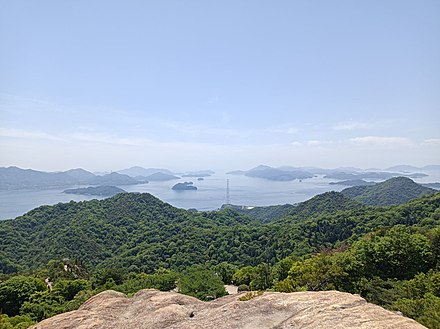Takehara - city in Hiroshima prefecture, Japan
Takehara (竹原) is a city of 26,000 people (2016) in Hiroshima Prefecture.
Understand
 Takehara City (竹原市) includes the main town of Takehara, a couple towns along the coast and the island of Okunoshima (大久野島). It is mainly famous for the latter island and Takehara Townscape Conservation Area, its preserved historical center.
Takehara City (竹原市) includes the main town of Takehara, a couple towns along the coast and the island of Okunoshima (大久野島). It is mainly famous for the latter island and Takehara Townscape Conservation Area, its preserved historical center.
From the Edo to the Meiji eras (17th-19th centuries), Takehara was a major center of trade and of salt and sake production. It is now a quiet country town living essentially on tourism and agriculture.
Get in
There is a bus from the Hiroshima airport. By train, Takehara is accessible via the Kure line.
Get around
You can get around the main town by walking. The adjacents towns are deserved by the Kure train (about every 1½ hr) and local buses.
See
 The Takehara Townscape Conservation Area is the remnant of the city's more prosperous days. Traditional houses of the former salt and sake merchants line up along the main street (hondori). Most of them are inhabited by families, while some of them are being used as shops, hotels and restaurants.
The Takehara Townscape Conservation Area is the remnant of the city's more prosperous days. Traditional houses of the former salt and sake merchants line up along the main street (hondori). Most of them are inhabited by families, while some of them are being used as shops, hotels and restaurants.
Standing out among the Japanese buildings, the white Western-style mansion is a former library and learning center. It now hosts a statue of Taketsuru Masataka, a pioneer of the Japanese whisky industry, and a small museum dedicated to the history and customs of the city.
Above the main street, a few temples give a panoramic view of the city.
Do
 Okunoshima, also known as "Rabbit island", famous for its numerous rabbits roaming the island. It was used before and during World War II as the site of a secret military base to conduct research and development of poisonous gas. It was disaffected after the war when the rabbits were introduced. The military buildings are still in place, a reminder of the island's dark past. Okunoshima is accessible by ferry from the port of Tadanoumi (忠海).
Okunoshima, also known as "Rabbit island", famous for its numerous rabbits roaming the island. It was used before and during World War II as the site of a secret military base to conduct research and development of poisonous gas. It was disaffected after the war when the rabbits were introduced. The military buildings are still in place, a reminder of the island's dark past. Okunoshima is accessible by ferry from the port of Tadanoumi (忠海).
From Tadanoumi, one can also hike the Kurotaki (黒滝) and Shirotaki (白滝) Mountains. The Kurotaki Mountain presents a series of Buddhist statues and some bas-relief sculpted directly into the rock (there are usually maps available at the bottom). Shirotaki Mountain offers a magnificent view over the islands.
Buy
There are several shops along the main street with souvenirs, local specialities, sake and so on. As of July 2022, many are closed during the week due to the lack of tourists.
Eat
Most activity is concentrated around the main street, with a couple more places around the Takehara station.
- Horikawa (ほり川). On the main street. A venerable okonomiyaki restaurant.
- Il traghetto. In a small street near the main one. A cosy Italian restaurant. The front door is very small, even by Japanese standards.
- Cantine Parisienne (カンティーヌ パリジェンヌ). About 10' north of the centre by car, somewhat accessible by bus. A French restaurant run by a Frenchman in a renovated traditional house.
Drink
- La passion / Climate. In front of the station. A "two-in-one" bar, with a wine bar ("La passion") and a sake bar ("Climate") in the same room but with separate counters. The wine bar offers local and world wines, while the sake bar is dedicated to the local production.
Sleep

- Nipponia Hotel. A fancy hotel in the traditional style of a Japanese ryokan in the middle of the main street.
Connect
Go next
Going along the Kure line you can go west towards Kure and Hiroshima, or east towards Mihara and Onomichi. With a ferry you can go south to the island of Osakikamijima (大崎上島), and eventually continue across the sea to Imabari on the Shikoku island.
Takehara
city.takehara.lg.jpTakehara-shi
2nd-order administrative division
Hiroshima Prefecture
Primary administrative division